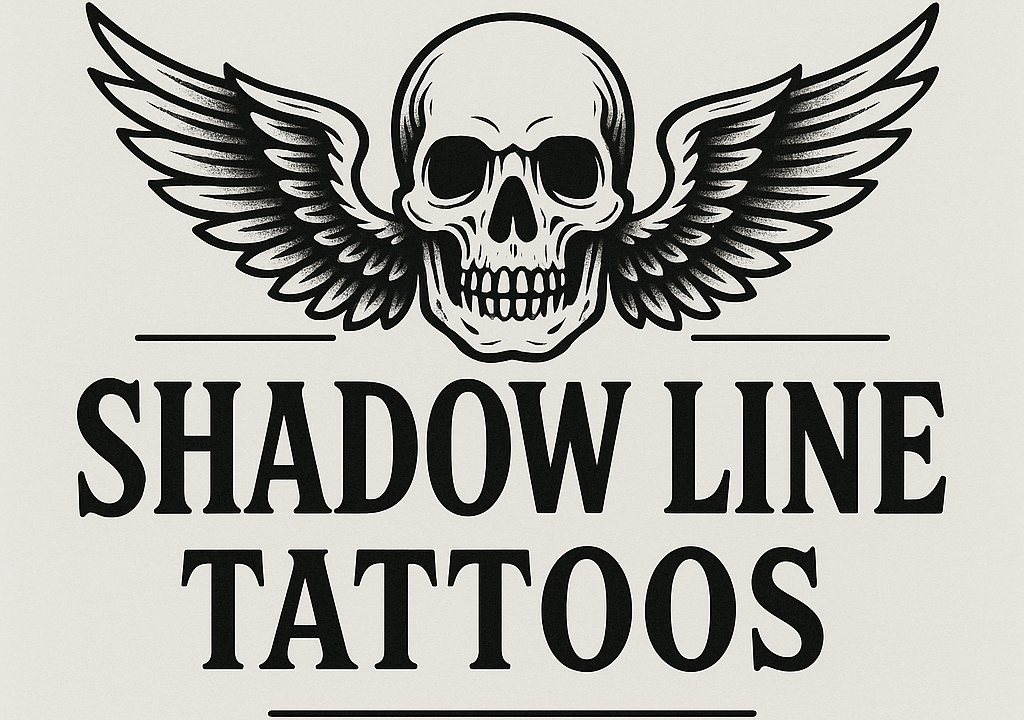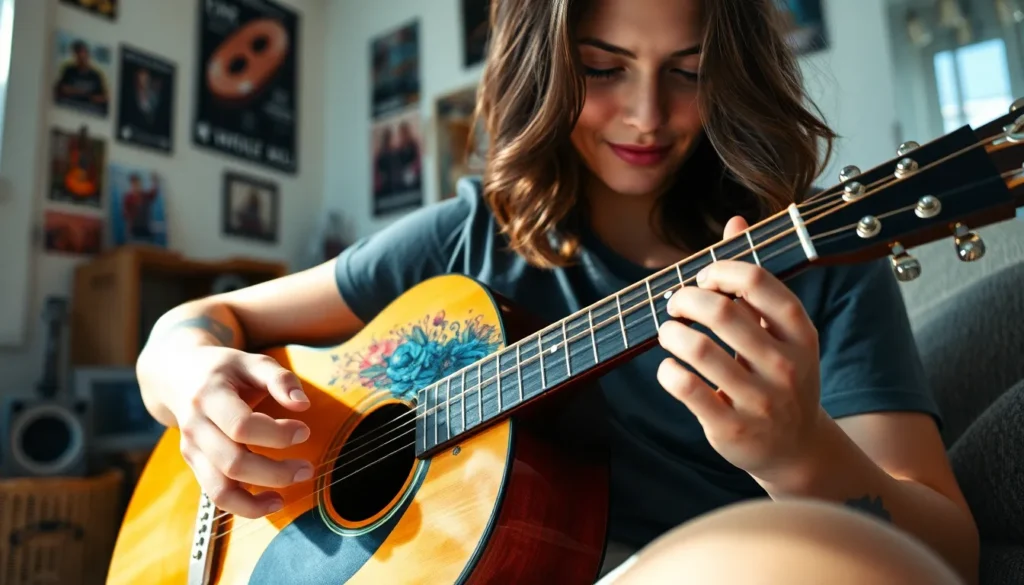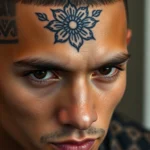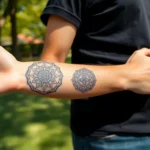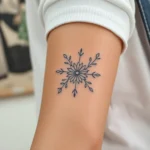Music flows through our veins and sometimes we need to wear that passion on our skin. Guitar tattoos represent more than just body art – they’re a permanent declaration of our love for music and the six-stringed instrument that speaks to our soul.
Whether you’re a seasoned guitarist or simply captivated by the guitar’s timeless appeal, we’ve discovered that these tattoos offer endless creative possibilities. From minimalist acoustic outlines to elaborate electric guitar masterpieces, there’s a design that perfectly captures your musical spirit.
We’ll explore the most striking guitar tattoo concepts that’ll make you want to book that appointment immediately. These aren’t just random designs – they’re carefully curated ideas that blend artistic beauty with musical meaning, ensuring your tattoo resonates with both your aesthetic preferences and your deep connection to music.
Classic Acoustic Guitar Silhouette Tattoos
Classic acoustic guitar silhouettes remain the most popular choice among music lovers seeking their first guitar tattoo. These timeless designs capture the instrument’s elegant curves and iconic shape without overwhelming detail.
Traditional Black Ink Designs
Bold black outlines define the most enduring acoustic guitar tattoo style we see today. These designs feature solid black fills or clean line work that emphasizes the guitar’s natural hourglass shape and distinctive sound hole.
Placement versatility makes traditional black ink guitars perfect for various body locations. We often recommend forearms, shoulders, and calves for these designs since they showcase the guitar’s full silhouette effectively.
Size flexibility allows traditional designs to work as small wrist tattoos or large back pieces. Artists typically use varying line weights to create depth and dimension within the simple black framework.
Cultural significance connects these tattoos to decades of acoustic music tradition. Many clients choose this style to honor folk, country, blues, and classical guitar influences that shaped their musical journey.
Watercolor Acoustic Guitar Art
Vibrant color splashes transform classic guitar silhouettes into modern artistic statements. These designs blend traditional black outlines with flowing watercolor techniques that create beautiful background washes in blues, purples, oranges, and greens.
Artistic techniques involve layering translucent colors behind or around the guitar outline. Skilled tattoo artists use color bleeding effects and paint drip elements to simulate actual watercolor painting on skin.
Emotional expression through color choice adds personal meaning to each watercolor guitar tattoo. We’ve seen clients select sunset hues for warm memories, ocean blues for calming influences, or rainbow spectrums to represent musical diversity.
Maintenance considerations require touch ups every 3 to 5 years since watercolor tattoos fade faster than traditional black ink. Quality artists use high grade pigments and proper saturation techniques to maximize color longevity.
Minimalist Line Work Styles
Single line drawings create elegant acoustic guitar tattoos using continuous, unbroken strokes. These ultra clean designs appeal to people who prefer subtle body art that maintains professional appearance standards.
Geometric interpretations reduce the guitar shape to essential angular elements while preserving recognition. Artists often incorporate triangular sound holes, rectangular necks, and simplified tuning peg arrangements.
Negative space utilization allows skin tone to become part of the design composition. We see many minimalist guitars that use clever spacing to suggest strings, frets, and body details without additional ink.
Micro tattoo applications make line work guitars perfect for finger placements, behind ears, or ankle locations. These tiny designs typically measure 1 to 3 inches and require precision needle work for clean execution.
Electric Guitar Tattoo Designs
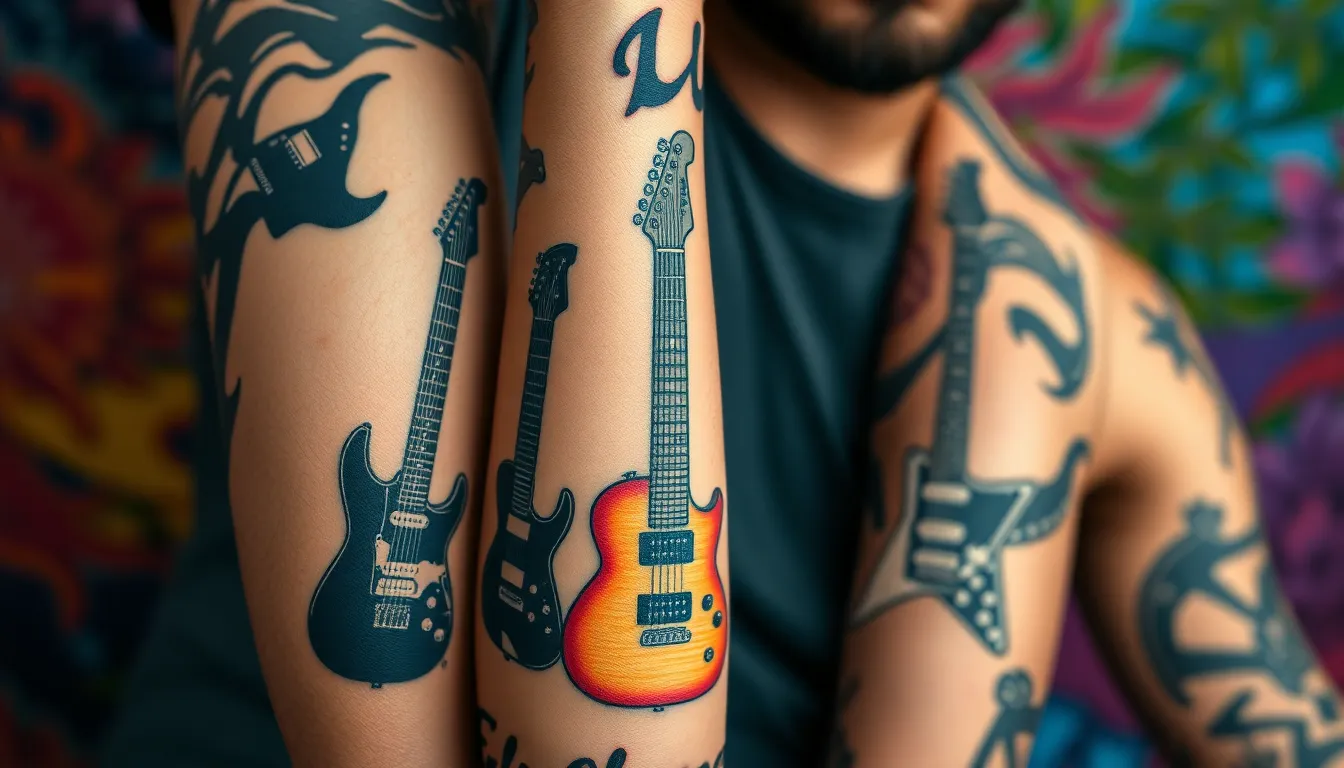
Electric guitar tattoos capture the raw energy and iconic appeal of amplified music. These designs offer endless possibilities for expressing your rock and roll spirit through bold, recognizable silhouettes.
Stratocaster and Telecaster Inspired Pieces
Stratocaster tattoos showcase one of music’s most recognizable guitar shapes with their sleek contoured bodies and distinctive headstock design. We often see these pieces emphasizing the guitar’s elegant curves and three pickup configuration, making them instantly identifiable to fellow musicians. Telecaster designs focus on the guitar’s simple yet iconic single cutaway body, which translates beautifully into clean tattoo lines that highlight the instrument’s timeless appeal.
Artists typically render these Fender inspired pieces with attention to the neck and body proportions that made these guitars legendary. Musicians gravitate toward these designs because both models represent foundational sounds in rock, country, and blues music. Placement options work well on forearms, shoulders, or back pieces where the guitar’s full length can be properly displayed.
Gibson Les Paul Tribute Tattoos
Les Paul tattoos celebrate the thick, substantial body shape that defines this legendary guitar model. These designs often incorporate the guitar’s distinctive arched top, dual humbucker pickups, and ornate binding details that make the Les Paul instantly recognizable. We see artists paying special attention to the headstock’s crown inlay and the guitar’s overall proportions that contribute to its rich, sustaining tone.
Bridge and tailpiece elements frequently appear in these tattoos, showcasing the hardware that contributes to the Les Paul’s legendary sound quality. Color variations range from classic sunburst patterns to solid colors that match famous players’ preferred finishes. These tribute pieces work exceptionally well as larger tattoos where intricate details like pickup rings and control knobs can be properly rendered.
Flying V and Explorer Bold Designs
Flying V tattoos feature the guitar’s dramatic angular body that creates striking geometric compositions on skin. These designs emphasize sharp points and bold lines that capture the instrument’s futuristic aesthetic, often incorporating vibrant colors that enhance the guitar’s eye catching appearance. We notice these tattoos work particularly well for clients wanting something that stands out from traditional guitar shapes.
Explorer designs showcase the guitar’s asymmetrical body with its unique pointed horns and offset design elements. Artists often use these guitars’ unconventional shapes to create ever-changing compositions that flow with body contours. Both models represent rebellion against traditional guitar design, making them perfect choices for musicians who want tattoos reflecting their bold musical personalities and preference for standing out from conventional approaches.
Musical Note and Guitar Combination Tattoos
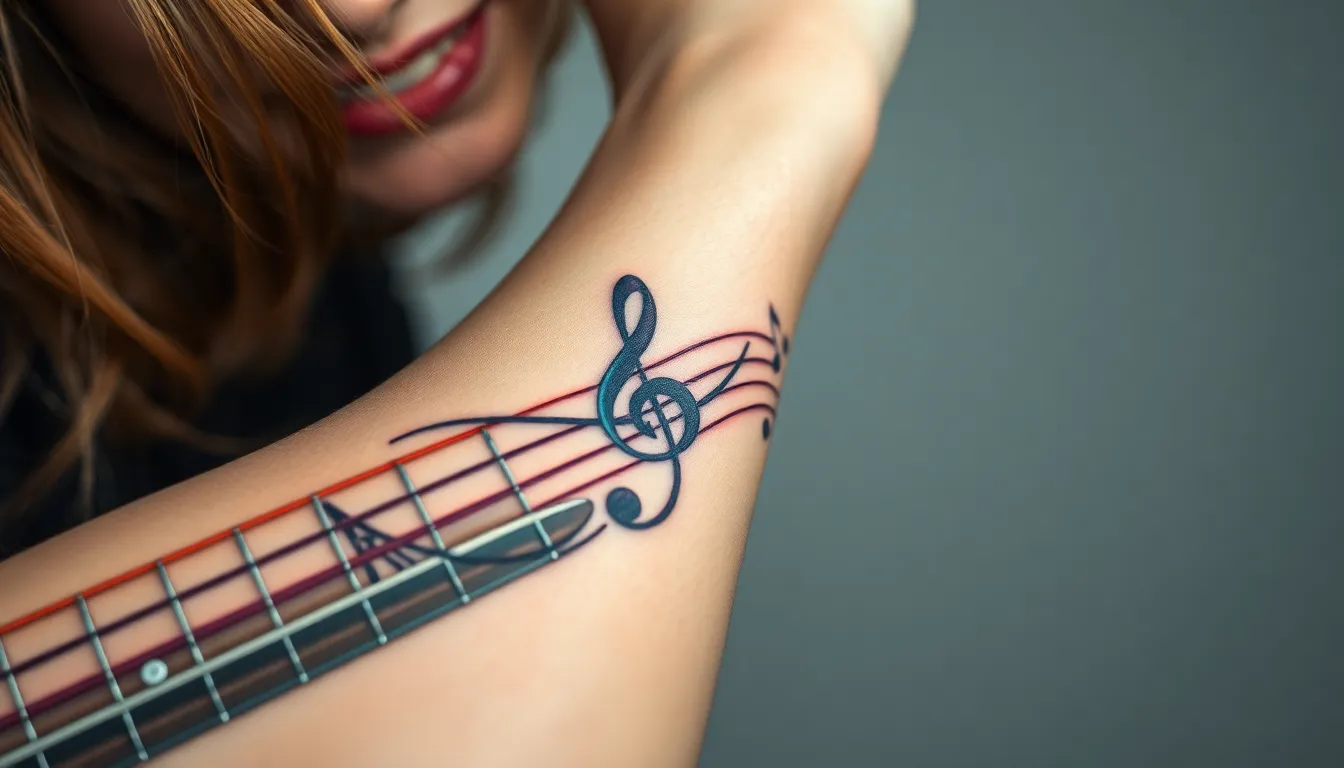
Musical elements combined with guitar imagery create some of the most meaningful tattoo designs for musicians and music lovers. These combinations symbolically connect music theory with the instrument itself, resulting in artwork that speaks to both visual and auditory passions.
Treble Clef Flowing Into Guitar Strings
Treble clef designs that seamlessly merge with guitar strings create stunning visual narratives about music creation. Artists often position the treble clef at the guitar’s headstock, allowing its curved form to naturally flow into the instrument’s tuning pegs and strings. This design creates a seamless connection between musical notation and the physical instrument that produces sound.
The flowing motion in these tattoos represents how music moves from written form to audible reality through the guitar. Many guitarists choose this design because it captures the transformation of musical ideas into actual sound. Placement options include the forearm, where the treble clef can extend from wrist to elbow, or the ribcage, where the natural curve complements body contours.
Sheet Music Wrapped Around Guitar Body
Sheet music elements wrapped around guitar bodies showcase the intimate relationship between written music and instrumental performance. These designs typically feature actual musical scores from favorite songs or compositions, creating deeply personal tattoo artwork. The sheet music appears to wrap organically around the guitar’s curves, suggesting that music and instrument are inseparable.
Artists can incorporate exact songs that hold special meaning, making each tattoo completely unique to the wearer. The musical notation adds texture and detail while maintaining readability for those who can interpret the notes. This design works particularly well on larger canvas areas like the back, thigh, or shoulder, where there’s sufficient space for both guitar details and musical notation.
Musical Staff Integrated Guitar Designs
Musical staff integration transforms the guitar itself into a functional piece of sheet music within the tattoo design. The guitar’s fretboard becomes part of the musical staff, with notes and rests positioned along the neck to create readable musical passages. This design demonstrates advanced understanding of both guitar mechanics and music theory.
Fret markers can double as note positions, while the strings align with staff lines to create authentic musical notation. The guitar’s body might feature additional staff lines extending from the neck, allowing for more complex musical arrangements within the design. These tattoos appeal especially to music teachers, composers, and serious students who appreciate the technical precision required to merge instrument and notation accurately.
Guitar Headstock and Tuning Peg Tattoos
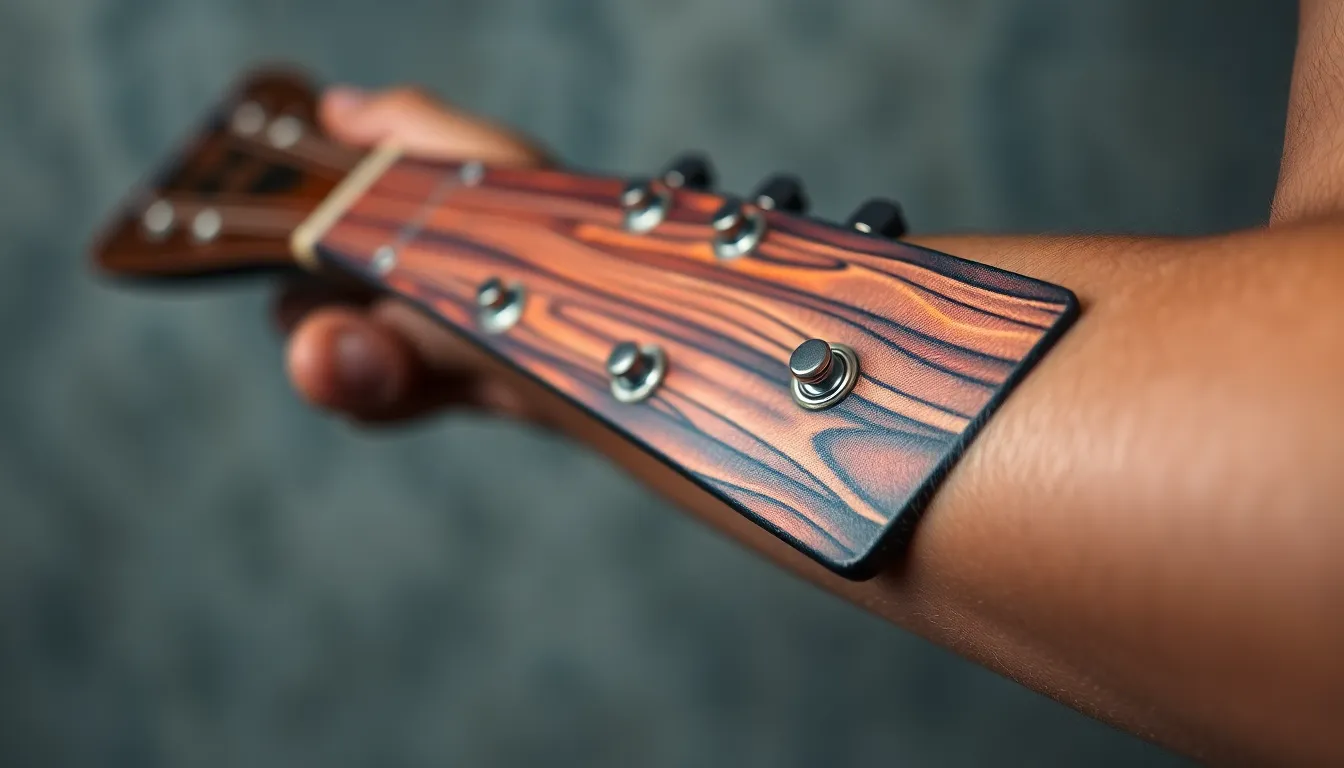
Moving beyond full guitar body designs, headstock tattoos offer a unique way to celebrate the most distinctive part of your instrument. These detailed designs focus on the mechanical beauty and brand identity that makes each guitar special.
Realistic Detailed Headstock Art
Photorealistic headstock tattoos capture every intricate detail of your guitar’s crown, from the wood grain patterns to the precise placement of tuning pegs. Artists specializing in black and gray realism excel at recreating the subtle shadows and textures that make these tattoos appear three-dimensional on skin. Color variations allow for stunning representations of exotic wood finishes like flamed maple or rosewood, bringing the natural beauty of premium guitar materials to life through ink.
Placement considerations for realistic headstock art typically require larger canvas areas such as the forearm or upper arm to accommodate the necessary detail work. Musicians often choose to immortalize their personal instrument’s headstock, creating a permanent tribute to the guitar that shaped their musical journey.
Vintage Tuning Machine Designs
Classic Kluson tuners from the 1950s and 1960s represent the golden age of guitar manufacturing, featuring elegant cream-colored buttons and chrome-plated housings that define vintage aesthetics. These intricate mechanical components translate beautifully into tattoo art, with their geometric shapes and functional beauty creating striking visual compositions.
Grover and Schaller vintage designs offer additional inspiration for tuning machine tattoos, each brand carrying its own distinctive style and historical significance. Artists can emphasize the mechanical precision of these components through detailed line work that showcases gears, screws, and adjustment mechanisms.
Nostalgic elements like aged patina effects or worn finish details add character to vintage tuning machine tattoos, reflecting the stories and history embedded in well-loved instruments.
Custom Logo and Brand Tributes
Fender headstock logos remain among the most recognizable guitar brand symbols, with their classic script lettering representing decades of rock and blues history. Gibson’s crown and script logo carries equal weight in guitar culture, symbolizing craftsmanship and premium sound quality that spans generations of musicians.
Martin acoustic branding appeals to fingerstyle players and folk musicians who appreciate the company’s 190-year heritage of acoustic guitar excellence. Custom interpretations of these logos can incorporate personal elements like your name, favorite song lyrics, or meaningful dates.
Boutique builder tributes allow for unique tattoo designs featuring lesser-known but equally respected guitar manufacturers like Paul Reed Smith, Taylor, or smaller custom shops. These designs often combine logo elements with distinctive headstock shapes, creating personalized tributes that reflect your exact musical taste and instrument preferences.
Guitar Pick and String Tattoos
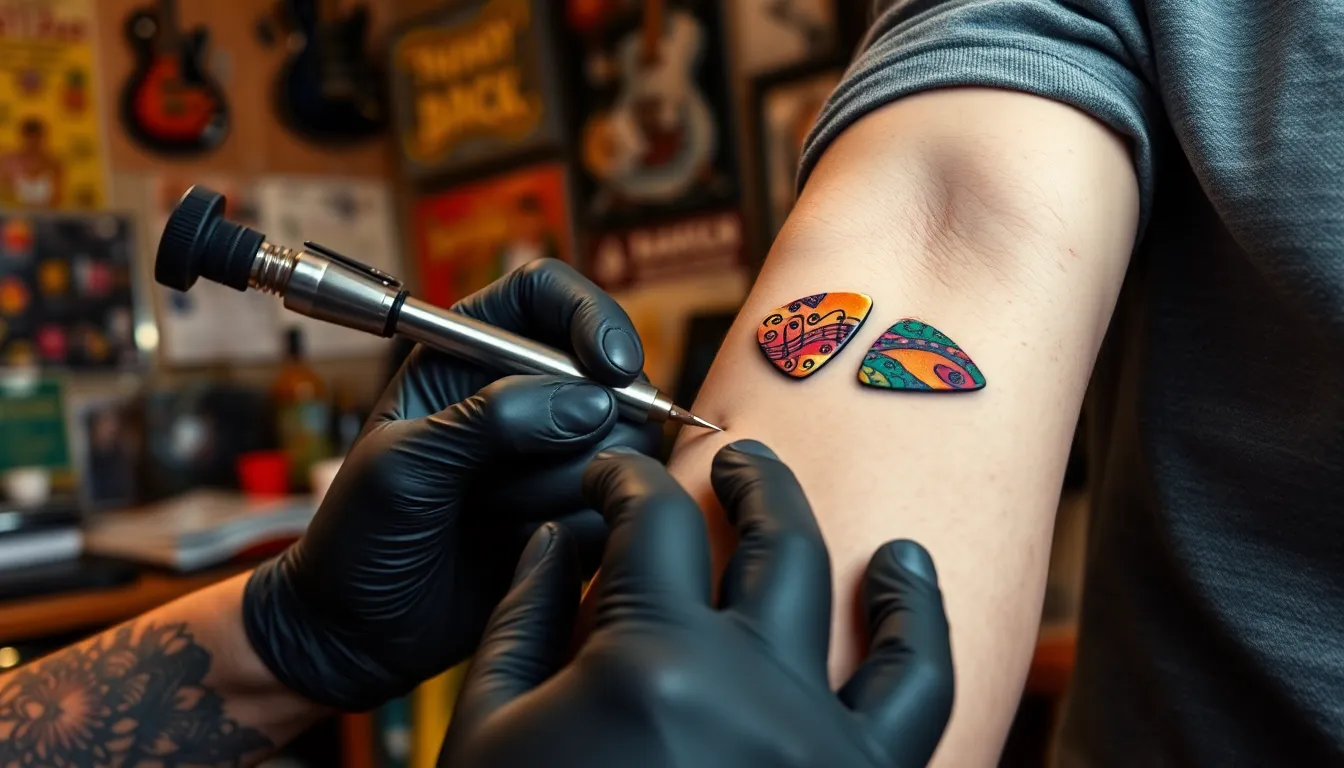
Moving beyond the guitar body itself, we find inspiration in the smaller yet essential components that bring music to life. These intimate details of the instrument offer unique tattoo opportunities that showcase technical appreciation and artistic creativity.
Floating Guitar Pick Collections
Creating a floating guitar pick collection tattoo involves arranging multiple picks across your skin to appear suspended in motion. We can design each pick with different patterns like waves, musical notes, or abstract geometric shapes that challenge the artist’s precision within the pick’s distinctive teardrop form.
Placing these collections works exceptionally well on forearms, shoulders, or along the ribcage where the picks can flow naturally with your body’s contours. Artists often scatter the picks randomly to create organic movement, while others arrange them in deliberate patterns that tell a musical story.
Customizing each individual pick allows for personal musical influences to shine through different colors, band logos, or meaningful symbols. We’ve seen collections where each pick represents a different musical era, favorite song, or important performance in the wearer’s life.
String Tension and Bridge Designs
Highlighting string tension creates dramatic tattoo opportunities that focus on the mechanical precision of guitar engineering. These designs emphasize the twisted metal strings under pressure, often incorporating abstract elements that transform technical components into artistic statements.
Incorporating bridge structures adds architectural interest to guitar tattoos, with saddles, springs, and adjustment screws becoming focal points of intricate line work. We can design these elements with geometric patterns that celebrate the instrument’s functional beauty while maintaining artistic appeal.
Adapting these technical concepts works particularly well for musicians who appreciate the craftsmanship behind their instruments. String and bridge tattoos often appeal to guitar technicians, luthiers, and serious players who understand the relationship between proper setup and musical expression.
Pick Guard Pattern Inspirations
Drawing inspiration from pick guard designs opens up endless geometric possibilities, from classic chevron patterns to intricate floral motifs that can be adapted to various tattoo styles. These patterns work exceptionally well when we need to fill larger areas while maintaining connection to guitar imagery.
Personalizing pick guard patterns allows for color customization that reflects your musical influences or personal aesthetic preferences. We can incorporate meaningful symbols, band references, or cultural elements within these geometric frameworks to create truly unique designs.
Scaling these patterns makes them versatile for different body placements, from small wrist pieces featuring simplified chevron work to larger back pieces showcasing elaborate floral interpretations. The repetitive nature of pick guard patterns creates rhythm and movement that mirrors the musical inspiration behind the tattoo.
Broken Guitar and Smashed Instrument Tattoos
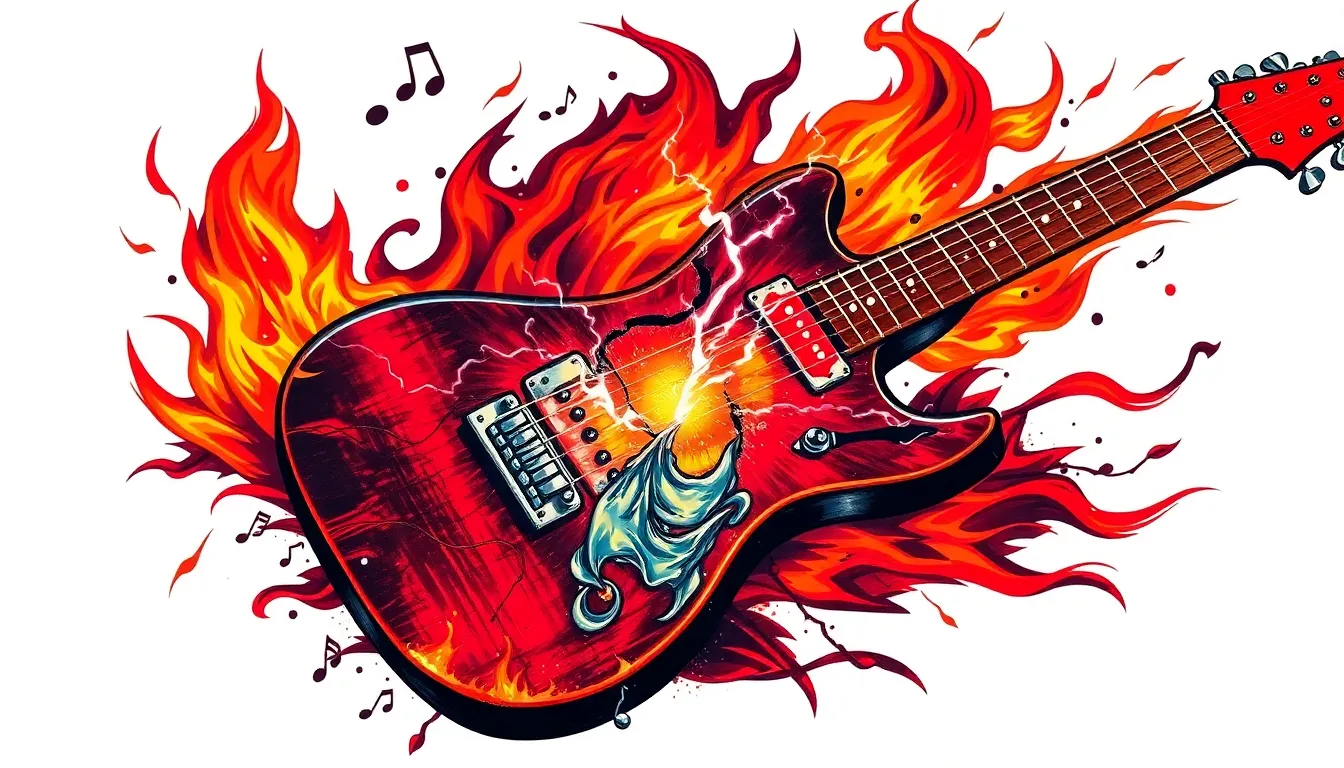
Moving beyond pristine instrument imagery, we explore designs that capture destruction as an art form. These powerful tattoos transform broken elements into meaningful symbols of resilience and musical transformation.
Rock and Roll Destruction Themes
Rock and roll destruction tattoos embody the rebellious spirit that defines this genre’s raw energy. Amplifiers engulfed in flames create dramatic focal points that represent the intensity of live performances. Shattered guitars caught mid-air showcase the explosive nature of rock music, while instruments being played aggressively communicate passion without restraint.
Musicians often choose these designs to reflect their connection between music and chaos as performance art. Broken drum kits, exploded cymbals, and fractured microphones add variety to traditional guitar imagery. Stage lighting effects, smoke, and electrical sparks enhance the overall destructive aesthetic.
Artists frequently incorporate iconic rock symbols like lightning bolts, skulls, or band logos into these chaotic scenes. Color palettes typically feature bold reds, oranges, and yellows against stark black backgrounds for maximum visual impact.
Cracked Body Artistic Interpretations
Cracked body designs focus on guitar surfaces marked by visible fissures and artistic damage. Lightning fills these cracks to create ever-changing energy that flows across the instrument’s surface. Flames emerge from fracture lines, symbolizing passion burning through adversity.
Water cascades through guitar body cracks, representing healing and renewal after hardship. Artists use these flowing elements to add movement and symbolic depth to static instrument shapes. Shading techniques emphasize the guitar’s fragility while highlighting its enduring strength.
Musicians appreciate how these designs represent overcoming challenges while embracing imperfection as beauty. Placement options include forearms, shoulders, and back pieces where crack patterns can follow natural body contours. Size variations range from small wrist pieces to large detailed compositions spanning entire limbs.
Exploding Guitar Ever-changing Designs
Exploding guitar tattoos capture instruments bursting apart with dramatic visual energy. Wooden splinters radiate outward from the guitar’s center, creating explosive movement patterns. Guitar strings snap and fly in different directions, adding realistic detail to the destruction scene.
Energy waves ripple from the explosion point, emphasizing the release of creative force. Sound waves, musical notes, or colorful energy bursts enhance the ever-changing feel of these designs. Artists use bright colors or high contrast black and white techniques for maximum visual impact.
Musicians choose these tattoos to represent inspiration, artistic breakthrough, or creative liberation. Placement considerations include areas where the explosive elements can spread naturally, such as chest pieces, back panels, or full sleeve designs. Custom elements like personal band logos or meaningful lyrics can integrate seamlessly into the exploding fragments.
Guitar Player Silhouette and Hand Tattoos
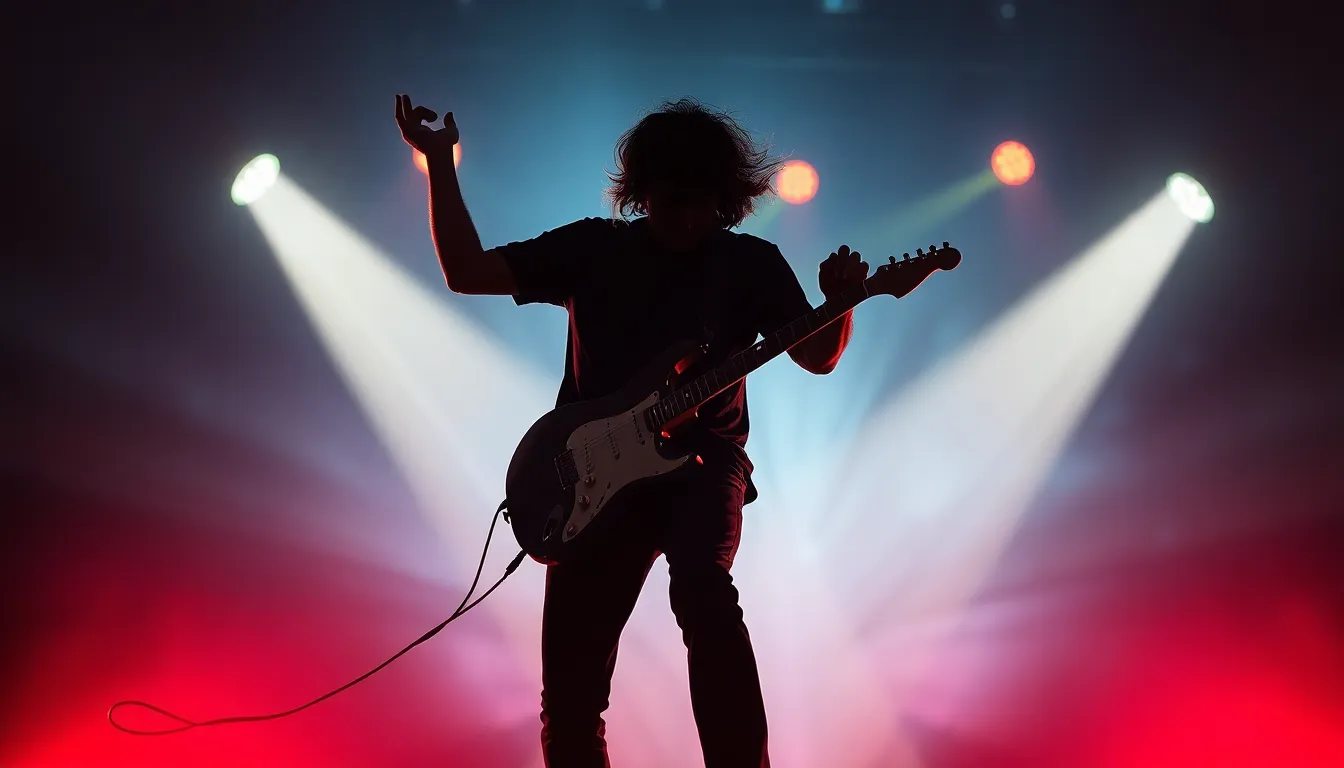
We’re diving into tattoo designs that capture the intimate connection between musician and instrument through human form and gesture. These designs emphasize the physical relationship between player and guitar, creating powerful visual narratives.
Finger Position Chord Diagrams
Finger position chord diagrams serve as permanent reminders of musical skills, tattooed directly onto hands or forearms where they’ll inspire daily practice. These designs illustrate exact chord finger positions with precise dot placements on fretboard representations, creating functional artwork that doubles as learning tools. Musicians often choose their first learned chord like G major or their favorite power chord progression for these meaningful tattoos.
Guitarists appreciate these tattoos because they transform technical knowledge into visible art, making complex finger positions instantly recognizable to fellow musicians. The designs work exceptionally well on forearms where the natural length mimics a guitar neck, allowing for detailed fret markings and clear finger position indicators. Some artists incorporate actual chord names or Roman numerals beneath the diagrams, adding educational value to the aesthetic appeal.
Strumming Hand Motion Art
Strumming hand motion art captures the ever-changing energy of guitar playing through flowing lines and movement patterns that seem to dance across the skin. These designs emphasize the sweeping gestures of strumming, often incorporating motion blur effects or trailing lines that suggest rhythm and tempo. Artists frequently use curved strokes and graduated shading to create the illusion of a hand in continuous motion, making the tattoo appear alive with musical energy.
Ever-changing strumming tattoos work particularly well on arms and shoulders where natural muscle movement enhances the illusion of motion during daily activities. The designs often feature hands positioned in perfect strumming form, with fingers slightly curled and wrist positioned at the optimal angle for guitar technique. Musicians choose these tattoos to represent their playing style, whether it’s aggressive rock strumming or gentle fingerpicking patterns.
Full Body Musician Silhouettes
Full body musician silhouettes encapsulate the complete essence of musical performance, showing guitarists in classic poses that define their relationship with the instrument. These striking designs often feature musicians mid performance, with guitars held in iconic positions like overhead rock poses or intimate acoustic stances. The silhouettes work effectively because they focus attention on the overall composition rather than intricate details, creating powerful visual statements about musical passion.
Musicians gravitate toward these tattoos because they represent the complete musical experience rather than just the instrument itself. The designs frequently incorporate environmental elements like stage lighting, amplifiers, or concert crowds to enhance the performance atmosphere. Artists often position these full body silhouettes on larger canvas areas like backs or thighs where the complete scene can unfold with proper proportions and visual impact.
Band Logo and Guitar Mashup Tattoos
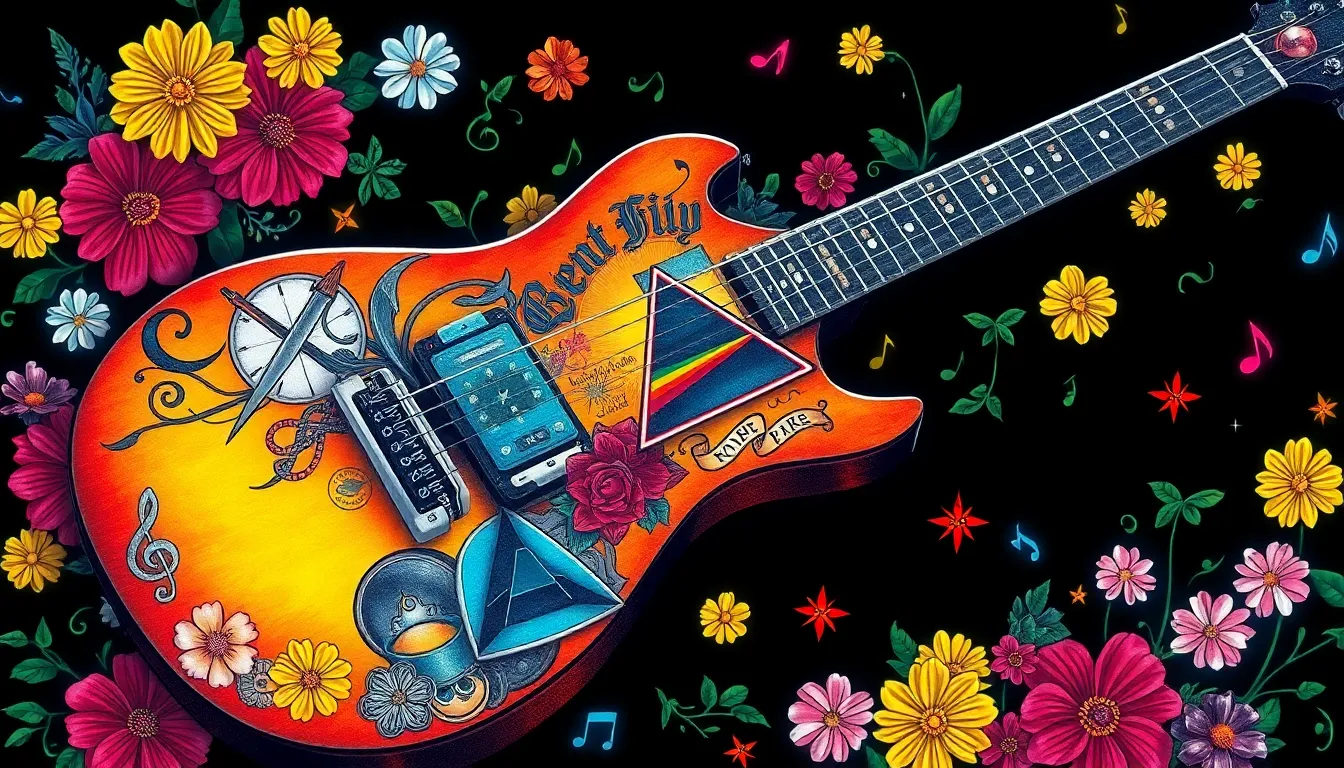
Merging beloved band imagery with guitar designs creates powerfully personal tattoos that celebrate both musical passion and artistic fandom. These mashup designs allow us to showcase our favorite artists while honoring the instrument that creates their signature sounds.
Famous Band Symbol Integration
Incorporating legendary band symbols into guitar body designs transforms ordinary instrument tattoos into iconic tributes. Led Zeppelin’s mystical Zoso symbols can flow across acoustic guitar curves, while the Grateful Dead’s “Steal Your Face” skull perfectly fits within electric guitar bodies. Rolling Stones tongue logos stretch naturally along guitar necks, creating ever-changing visual movement that mirrors rock and roll energy.
Pink Floyd’s prism design works beautifully when integrated into guitar string arrangements, with light rays emanating from the headstock area. AC/DC’s lightning bolt symbol electrifies guitar tattoos when placed strategically across the instrument’s body. These symbolic integrations require careful planning to maintain both the band’s visual identity and the guitar’s recognizable silhouette.
Album Cover Guitar Tributes
Transforming iconic album artwork into guitar shaped canvases creates stunning tribute pieces that honor musical history. The Beatles’ “Sgt. Pepper’s Lonely Hearts Club Band” collage can wrap around acoustic guitar bodies, with colorful character portraits filling the instrument’s curves. Pink Floyd’s “Dark Side of The Moon” prism design flows perfectly across electric guitar bodies, with rainbow light beams extending through the strings.
Hotel California’s desert industry imagery translates beautifully into guitar silhouettes, capturing the album’s mystical atmosphere within the instrument’s frame. Nirvana’s “Nevermind” underwater theme creates ethereal guitar designs when combined with flowing water elements around the instrument. These album tribute tattoos require larger canvas areas to capture the detailed artwork while maintaining the guitar’s structural integrity.
Music Festival Theme Designs
Festival inspired guitar tattoos capture the communal spirit and artistic energy of live music experiences. Coachella’s bohemian aesthetic translates into guitar designs featuring desert flowers, geometric patterns, and sunset color palettes flowing across instrument bodies. Woodstock themed guitars incorporate peace symbols, muddy textures, and psychedelic swirls that represent the festival’s countercultural legacy.
Burning Man inspired designs feature flames dancing around guitar strings with desert landscapes forming the instrument’s body. Bonnaroo’s farm festival atmosphere creates guitar tattoos with sunflower patterns, barn wood textures, and music note trails flowing from the headstock. These festival designs often incorporate temporary tattoo elements like flower crowns or face paint patterns, creating layered compositions that celebrate the complete festival experience.
Abstract and Geometric Guitar Tattoos
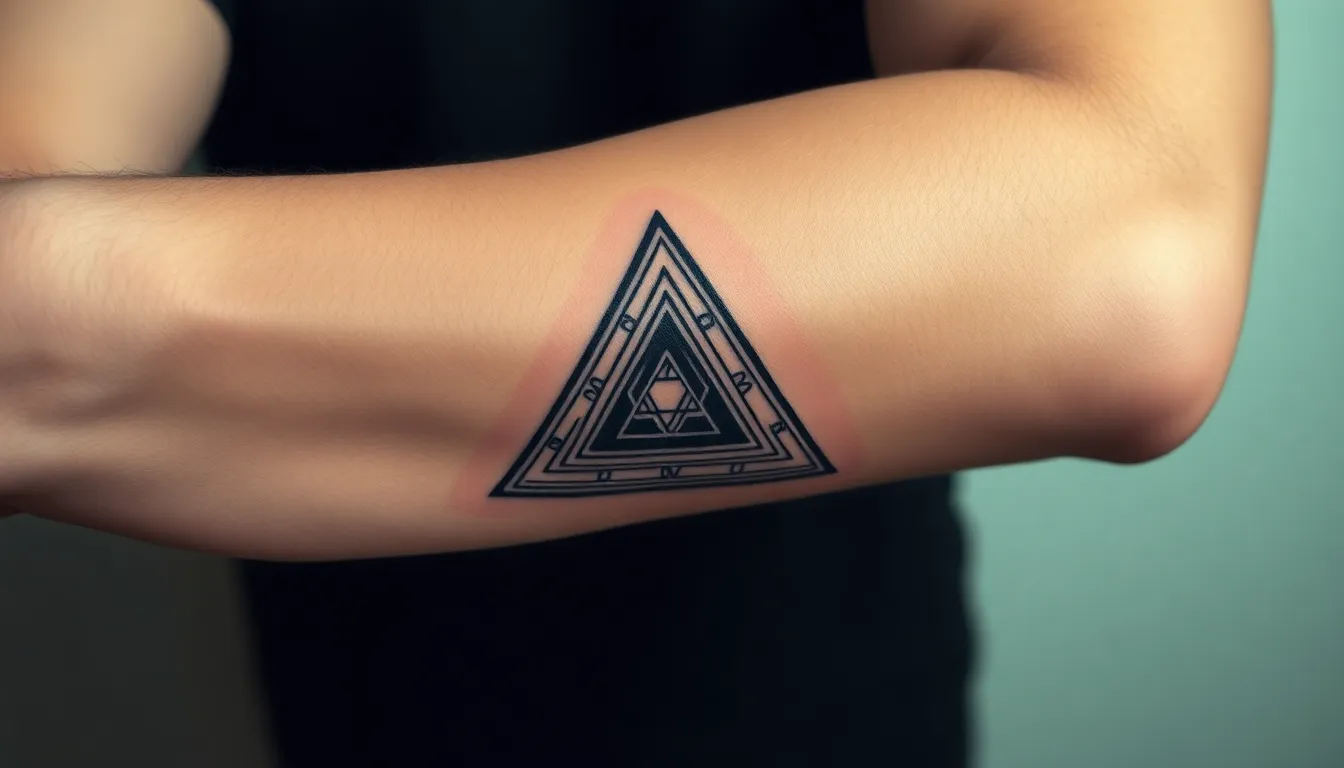
Moving beyond traditional guitar imagery, abstract and geometric designs offer a contemporary approach to musical body art. These modern interpretations transform the familiar guitar silhouette into bold artistic statements that emphasize form, structure, and mathematical beauty.
Triangular and Angular Guitar Shapes
Triangular guitar bodies create striking visual impact through their bold geometric simplicity. Sharp angular lines replace the traditional curved contours, resulting in designs that feel both futuristic and powerfully modern. We see these triangular interpretations working exceptionally well as minimalist tattoos, where clean lines and precise angles take center stage.
Angular guitar necks complement these geometric body shapes by emphasizing straight lines and sharp transitions. The combination creates a cohesive design that speaks to musicians who appreciate both musical precision and mathematical beauty. These designs work particularly well for placement on forearms and calves, where the angular shapes can follow natural body contours.
Chevron patterns integrated into triangular guitar designs add ever-changing movement and visual interest. Hexagonal elements can accent the body or form the sound hole, creating intricate geometric networks that catch the eye. The stark contrast between sharp angles and smooth skin creates a compelling visual dialogue that celebrates both music and modern design aesthetics.
Sacred Geometry Musical Instruments
Sacred geometric patterns transform guitar tattoos into spiritual and philosophical statements about music’s universal nature. The Seed of Life pattern, when incorporated into guitar body designs, symbolizes the creative potential that music holds within our lives. These intricate circular patterns create stunning focal points that represent harmony between mathematical perfection and musical expression.
Flower of Life designs integrated into guitar silhouettes celebrate the interconnectedness between music and natural rhythms. The overlapping circles create depth and complexity while maintaining the recognizable guitar shape. Musicians drawn to these designs often connect deeply with music’s role as a universal language that transcends cultural boundaries.
Geometric harmony patterns can replace traditional sound holes or decorate the guitar body with meaningful symbols. The golden ratio spiral incorporated into guitar curves creates designs that feel both ancient and contemporary. These sacred geometry elements appeal to musicians who view their create as more than entertainment, seeing music as a pathway to deeper understanding and connection.
Mandala-Style Guitar Body Art
Mandala patterns integrated into guitar tattoos create some of the most visually stunning and spiritually meaningful designs available. These intricate circular patterns transform the guitar body into a meditation on unity, wholeness, and the cyclical nature of musical creation. The detailed work required for mandala guitars makes them perfect choices for larger tattoo pieces that can showcase the full complexity of the design.
Intricate mandala details can include natural elements like flowers, leaves, and vines that spiral outward from the guitar’s center. These organic additions soften the geometric precision while maintaining the overall mandala structure. The combination creates designs that celebrate both the mechanical precision of the instrument and the organic flow of musical creativity.
Symmetrical mandala patterns radiating from the guitar’s sound hole create powerful focal points that draw the viewer’s attention inward. Each ring of the mandala can represent different aspects of musical journey, from initial inspiration to final performance. These designs require skilled tattoo artists who can maintain the precise symmetry essential to authentic mandala work while adapting the patterns to complement the guitar’s natural shape.
Small and Delicate Guitar Tattoos
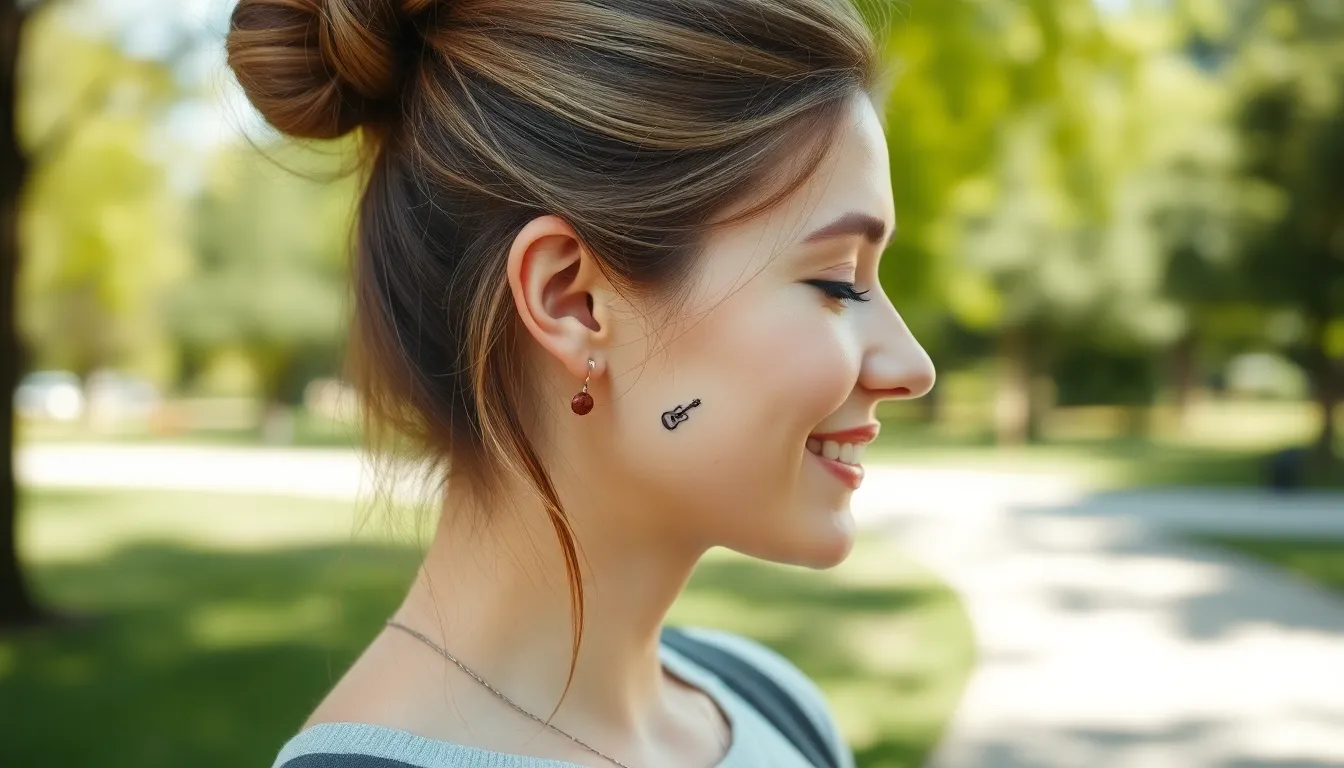
Musicians seeking subtle yet meaningful body art often gravitate toward small and delicate guitar tattoos that whisper rather than shout their musical devotion. These intimate designs capture the essence of musical passion while maintaining an elegant, understated aesthetic that complements any lifestyle.
Behind the Ear Miniature Guitars
Placement behind the ear creates an intimate canvas for miniature guitar tattoos that remain beautifully discreet yet accessible when you want to showcase your musical identity. Artists can create these tiny instruments with remarkable detail, from simple silhouettes to intricate line work that captures the guitar’s distinctive curves. We recommend single line guitar designs that flow gracefully around the ear’s natural contours, creating an elegant statement piece that’s only visible when you pull back your hair.
Continuous line guitars work exceptionally well in this placement, offering sophisticated simplicity that catches light beautifully. The curved space behind your ear perfectly accommodates the guitar’s body shape, while the neck can extend slightly toward your hairline for balanced proportions. Many musicians choose this placement because it allows them to keep their musical passion private in professional settings while revealing it during personal moments.
Wrist and Ankle Placement Ideas
Wrist placement offers incredible versatility for small guitar tattoos, whether you prefer the inner wrist’s intimacy or the outer wrist’s bold visibility. Inner wrist designs typically feature vertical guitar orientations that follow your arm’s natural lines, while outer wrist placements can accommodate horizontal layouts that wrap slightly around your wrist. We’ve noticed that guitar silhouettes work particularly well here, creating clean, recognizable shapes that maintain their impact at smaller sizes.
Ankle placements provide an elegant canvas for delicate guitar tattoos that add musical flair to your every step. The ankle’s curved surface naturally complements guitar body shapes, particularly when positioned just above the ankle bone where it catches attention without overwhelming the area. Tiny guitar designs placed here create beautiful focal points that peek out from shoes or complement bare feet, making them perfect for musicians who want their passion visible during casual moments.
Finger Guitar Micro Tattoos
Finger tattoos demand exceptional precision, making them ideal for minimalist guitar designs that capture maximum impact in minimal space. Single line guitars work beautifully across finger widths, while tiny guitar silhouettes can fit perfectly on individual finger segments. We recommend placing these micro designs on the side of fingers rather than knuckles, as this placement experiences less wear and maintains cleaner lines over time.
Symbolic finger guitar tattoos represent creativity and musical passion in their most concentrated form, making them deeply meaningful choices for dedicated musicians. Ring finger placements create particularly intimate statements about your musical commitment, while index finger designs can serve as daily reminders of your artistic goals. The precision required for finger guitar tattoos makes them perfect conversation starters that showcase both your musical dedication and appreciation for detailed craftsmanship.
Conclusion
Guitar tattoos offer endless possibilities for expressing our musical passion through body art. Whether we’re drawn to classic acoustic silhouettes or bold electric designs each style tells our unique musical story.
From minimalist line work to intricate geometric patterns these tattoos can be as subtle or statement-making as we desire. The beauty lies in how we can personalize every element – from vintage tuning pegs to abstract interpretations that reflect our individual artistic vision.
Our connection to music deserves meaningful representation and guitar tattoos provide that perfect bridge between passion and permanent art. They’re not just tattoos – they’re visual symphonies that celebrate the instrument that moves our souls and defines our musical journey.
Frequently Asked Questions
What makes guitar tattoos a popular choice for musicians?
Guitar tattoos offer a powerful way to express musical passion and identity. They connect deeply with musicians’ personal experiences, representing countless hours of practice, emotional expression, and artistic growth. The versatility of guitar designs allows for both subtle and bold statements, making them appealing to everyone from casual players to professional musicians.
Which guitar tattoo design is best for first-time tattoo seekers?
Classic acoustic guitar silhouette tattoos are ideal for beginners. These designs feature bold black outlines that emphasize the guitar’s recognizable shape, are versatile in placement and size, and offer timeless appeal. They’re simple yet meaningful, making them perfect for those new to both tattoos and guitar symbolism.
How do watercolor guitar tattoos differ from traditional designs?
Watercolor guitar tattoos incorporate vibrant colors and artistic techniques that create modern, painterly effects. Unlike traditional black outline designs, they use flowing colors, gradients, and artistic brushstroke effects. However, they require more maintenance and may fade faster than traditional tattoos, making aftercare crucial for longevity.
What are the most popular electric guitar tattoo styles?
Popular electric guitar tattoos include Stratocaster and Telecaster designs, Gibson Les Paul tributes, and bold Flying V or Explorer shapes. These designs capture the raw energy of amplified music and rock culture. They’re perfect for musicians wanting to showcase their electric guitar passion and stand out with recognizable iconic shapes.
Can guitar tattoos incorporate musical notation elements?
Yes, guitar tattoos can beautifully combine with musical elements like treble clefs flowing into strings, sheet music wrapped around guitar bodies, or musical staff integrated designs. These combinations create meaningful artwork that connects music theory with the instrument, appealing especially to music teachers and serious students.
Are small guitar tattoos as impactful as larger designs?
Small guitar tattoos can be incredibly meaningful and elegant. Miniature designs behind the ear, on wrists, ankles, or fingers offer intimate expressions of musical passion while maintaining subtlety. These delicate tattoos capture the essence of musical love without overwhelming the wearer, perfect for those preferring understated body art.
What do broken or smashed guitar tattoos symbolize?
Broken guitar tattoos represent the chaotic energy of rock and roll, artistic destruction, and creative breakthroughs. They capture themes of resilience, renewal, and the explosive nature of musical inspiration. These designs appeal to musicians who embrace imperfection and chaos as part of their artistic expression and performance energy.
How can band logos be incorporated into guitar tattoos?
Band logos can be seamlessly integrated into guitar designs through creative placement on the guitar body, headstock, or as part of the overall composition. Popular approaches include incorporating iconic symbols like Led Zeppelin’s Zoso or Rolling Stones’ tongue logo, creating personalized tributes that celebrate both musical fandom and guitar passion.
What are geometric guitar tattoos and who do they appeal to?
Geometric guitar tattoos use triangular, angular shapes and sacred geometry patterns to create contemporary musical art. They appeal to musicians who appreciate mathematical precision, spiritual symbolism, and modern aesthetic approaches. These designs transform traditional guitar imagery into striking visual statements that emphasize music’s universal and mathematical nature.
How do I choose the right placement for my guitar tattoo?
Consider your lifestyle, profession, and personal style when choosing placement. Larger, detailed designs work well on arms, back, or thighs, while small, delicate tattoos suit wrists, ankles, or behind ears. Think about visibility preferences, pain tolerance, and how the tattoo will age in different body areas.
